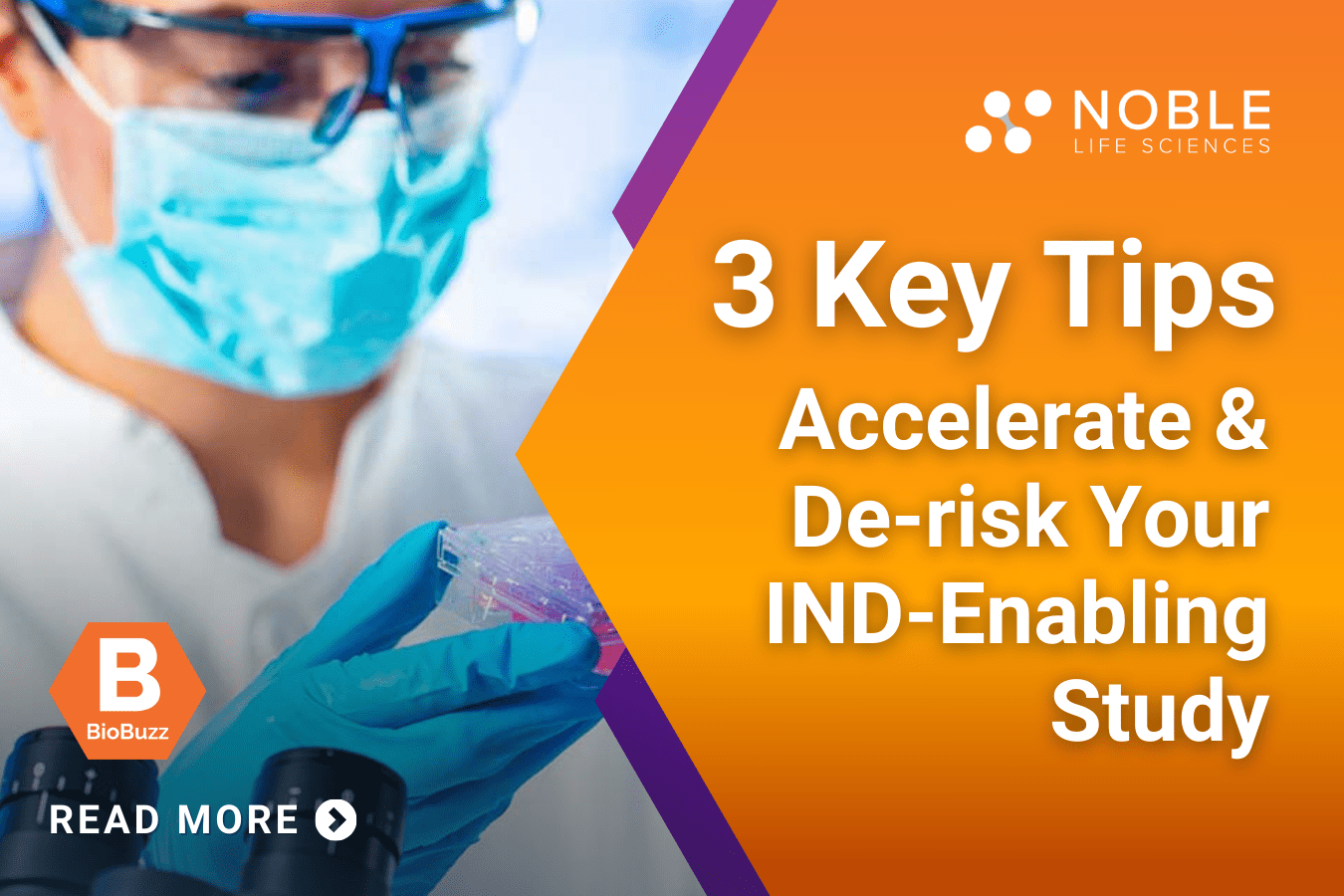
3 Tips for Accelerating and De-risking Your IND-Enabling Study Timeline
Learn effective strategies to expedite your IND-enabling studies. Discover how to efficiently and effectively streamline and schedule preclinical studies to meet your regulatory submission milestone.
By Mark Terry | December 6, 2023
Brought to you by Noble Life Sciences
| Noble Life Sciences is an Industry Partner who values community just as much as we do. They are a contract research organization (CRO) that provides a full continuum of preclinical drug, vaccine and medical device development services, from initial product discovery to GLP-compliant studies. Enjoy the read and be sure to get in touch if you have an idea or perspective you’d like to share. BioBuzz welcomes guest posts and contributing writers with expertise on topics that are of interest. |
Introduction
When a biotech or pharmaceutical company decides to advance its compound in human clinical trials, it must submit an Investigational New Drug (IND) application to the FDA or possibly to other non-US regulatory bodies. The primary purpose of the IND application is to provide data that the experimental compound is “reasonably safe for use in humans,”1 and shows enough pharmacological and biological activity to suggest likely clinical use and commercial development. Data are generated, collected, and analyzed during preclinical testing and presented to the regulatory agencies for review.
The IND application requires data in three broad areas:
- Animal Pharmacology and Toxicology Studies. This data is to determine reasonable safety in humans. It can include information on any previous use of the drug in humans, including foreign use.
- Manufacturing Information. This data is evaluated to determine if the company can produce and supply consistent batches of the compound. It will include information associated with the composition, manufacturer, stability, and controls utilized to manufacture the drug substance and drug product.
- Clinical Protocols and Investigator Information. This part of the IND application includes detailed protocols for the conduct of the clinical trial, information on the background and qualifications of the clinical investigators who lead the trials, and various oversight protocols, such as informed consent, institutional review board (IRB), and an agreement to comply with IND regulations.1
Sponsor companies often work with Contract Research Organizations (CROs) to perform preclinical testing leading up to an IND submission, as well as support the clinical trial and commercialization processes. Here are 3 tips for more efficiently conducting your IND-enabling tests.
3 Tips for More Efficient IND-Enabling Testing
#1. Plan your IND strategy early.
Engaging a regulatory consultant or testing partner, such as a CRO, can assist in outlining your IND program to plan your IND filing goals efficiently and reliably. The number, type, and design of preclinical studies depends on the product profile as well as the potential clinical development plan. Various factors to consider include the drug’s class, route of administration, dose, and the expected duration of treatment. Typical IND-enabling activities include pharmacology, pharmacokinetic, and toxicology studies.
The toxicology evaluations vary for small molecule versus biologic therapies. For example, small molecule preclinical studies require toxicology testing in two species, rodent, and non-rodent, along with mutagenicity and cytogenetic tests to evaluate genotoxicity. Biologics potentially only require tests in a single species depending on the availability of relevant animal models. Genotoxicity studies are often not necessary because biologics don’t usually interact with DNA inside cells.
Your IND strategy should include pre-IND meeting planning and response, creating a timeline for the completion of documentation for IND submissions, and early interactions with regulatory agencies such as the FDA and the European Medicines Agency (EMA). Working with a regulatory toxicologist as a consultant or via a CRO is extremely valuable for determining the appropriateness of the proposed studies and offering input on study design.
#2. Select your IND-enabling testing partner early.
An experienced CRO partner can assist in designing your IND program so it is efficient, effective, and compliant with agency feedback and current guidance. One of the greatest challenges for sponsor companies during the IND-enabling preclinical phase is scheduling, coordination, and proper documentation. Working with your CRO early provides time to get all the pieces of your development plan into place, which can depend on room and animal availability, and any manufacturing or supply chain issues that may occur.
Additional benefits include:
- Optimize scheduling of studies – many studies have long lead times or reporting times and must be initiated early in the planning process.
- Avoid scheduling delays.
- Coordinate various components of the overall drug development program so bottlenecks don’t occur.
- Help identify special considerations/challenges based on your type of therapeutic, formulation, route of administration, etc.
IND-enabling studies are highly dependent upon meticulous coordination and careful execution. Having all parties clearly understand their roles and responsibilities can significantly benefit a smooth schedule from preclinical to clinical studies.
#3. Plan your pre-IND meeting to be as informative as possible.
Before launching IND-enabling activities, schedule a pre-IND meeting with regulators to get feedback. Proper preparation can ensure you haven’t missed any important elements so you can stay on schedule, on budget, and maximize the likelihood of acceptance of your IND.
Sponsors are encouraged to reach out to regulators as early in the process to confirm their manufacturing processes and study design are acceptable and sufficiently informative. Often, sponsors of startup biotech companies that are experts in their area of science and technology don’t realize they can get valuable guidance from regulators well before the regulatory submission. Having close ties between regulatory agencies and innovators is vital to successful IND approvals and well-designed clinical studies.
Conclusion & Call to Action
Preclinical and pre-IND testing and activities are essential to progressing a drug into human clinical trials and eventually to the market. During this period of drug development, it’s easy for sponsor companies to get caught up in the science without thinking ahead to the necessary regulatory hurdles required to move into clinical trials. To prevent wasting time and resources, it’s better if companies plan early, working throughout the process with contract research organizations such as Noble Life Sciences and communicating with regulators such as the FDA and EMA as clearly as possible.
To find out more about how to effectively plan your IND-enabling activities, speak to a representative of Noble Life Sciences today.
Sources
- Investigational New Drug (IND) Application. U.S. Food & Drug Administration. https://www.fda.gov/drugs/types-applications/investigational-new-drug-ind-application
- About the Author
- Latest Posts
Mark Terry is a freelance writer, editor, novelist and ghostwriter. He holds a degree in microbiology & public health and spent 18 years in infectious disease research and clinical and research genetics prior to his transition to a writing career. His areas of expertise include biotechnology, pharma, clinical diagnostics, and medical practice management. He has written literally thousands of articles, as well as market research reports, white papers, more than 20 books, and many other written materials. He currently lives in Michigan with his family.





